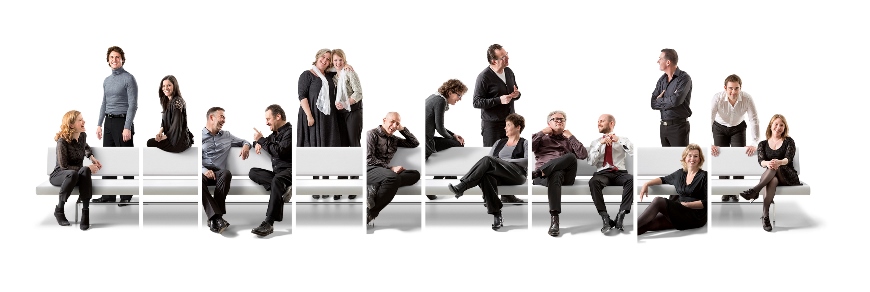80 years of singing
The impact of the oeuvre of Johann Sebastian Bach is so mighty that the literature on the subject would almost certainly fill an entire library. However, while it is well documented that Bach shaped the thinking of generations of composers, it is less well known that Bach has also often been the catalyst behind the formation of musical ensembles, even centuries after his passing. For instance, the 80-year-old Nederlands Kammerkoor, which hails from Utrech, can thank Bach for their foundation, albeit indirectly.
In 1937 Roger Schoute, a member of the socialist Vereeniging van Arbeiders Radio Amateurs (Workers’ Association of Radio Amateurs) charged the youthful conductor Felix de Nobel with assembling a choir that would be involved in performing radio broadcasts of Bach cantatas. For one season the ensemble, Chorus Pro Musica, featured solely in studio concerts. They gave their first public concert in Haarlem in 1939, by then under the name they are known today, Nederlands Kammerkoor (Netherlands Chamber Choir).

Nederlands Kammerkoor
Originally, the choir were composed of the best young Dutch singers of the day – from among them several went on to pursue impressive solo careers – but De Nobel was soon forced to realize that he would never be able to create a homogenous-sounding vocal ensemble out of opera and oratorio singers who constantly and stridently “all tried to roar the loudest”. After weathering the Second World War, in 1946 De Nobel appeared once again with a newly structured choir put together on the basis of different principles. The choir gained permanent members and they rehearsed several times a week; the changes not only impacted the singers but De Nobel’s leadership methods, too: he now directed the choir with a stronger, frequently autocratic hand.
They operated for one year in the service of the state radio and were then forced to stand on their own feet. This did not stop De Nobel from shaping a repertoire for the choir that spanned five centuries of music. The investment in time and effort paid dividends, with concert successes and regular invitations to appear abroad, including the famous Edinburgh Festival (1951); then from 1953 the Dutch state began supporting the ensemble with a regular subsidy which allowed singers to be employed full time. From this moment there were very few changes in the makeup of the choir. Their first golden era lasted until the late 1960s. During this period they collaborated in opera productions at the Holland Festival, not to mention making multiple tours of North America. The ensemble commissioned or inspired numerous new works from the pens of local composers, as well as from the likes of Frank Martin and Francis Poulenc. They also established close relations with Luigi Dallapiccola and Zoltán Kodály.
The 1970s posed serious challenges for the choir: artistic directors came and went while they rejuvenated themselves, formulating new artistic objectives. The declining state of health of De Nobel meant he had to quit in 1972, but choir members were unprepared for changes in leadership or membership as there had been no precedent for these in previous decades. Selection of a new leader was further complicated by the fact that the days of similarly hard-line authoritarian conductors was over. After De Nobel, Hans van den Hombergh (1972–1976) and then Kerry Woodward (1977–1980) took over. The Netherlands Chamber Choir had built a reputation primarily in Renaissance and Baroque music, but they were seriously challenged in this area by the then nascent early music movement, to which they had to react in some way.
The transformation was completed by 1980. The membership was rejuvenated, and from then on the choir were led not by a strong principal conductor but instead by guest conductors who were invited for specific projects. At this time the choir also re-joined the early music movement. Alongside this they worked with new music specialists and major ‘all-round’ conductors. By the mid-1980s the choir had regained their former lustre and – after a seven-year interregnum – the time was right to engage a new leader. Uwe Gronostay was appointed in 1987 and was tasked to preserve the choir’s homogenous sound. He did this mainly by revitalizing the late Romantic repertoire so beloved by members.
In 1997 the Dane Ivar Munk became the new artistic director, thereby splitting the functions of artistic director and principal conductor. One year later they elected the Estonian Tõnu Kaljuste to be the first non-Dutch principal conductor of the choir; he was replaced by Englishman Stephen Layton in 2002. They introduced important changes to the repertoire: the choir are now increasingly engaged with works by contemporary composers like Tavener and Pärt, and 20th-century figures less known as choral composers, such as Milhaud, Martinů and Taneyev. Their most recent undertaking is Project 14–18, in which modern-day composers have been asked to set to music poems written during the First World War. Between 2005 and 2011, like in the early 1980s, they functioned without a principal conductor, before Risto Joost was appointed to the position (2011–2015), who was followed by Peter Dijkstra (2015–).
Today, the Netherlands Chamber Choir, justly celebrated for their remarkably homogenous sound, are one of the leading vocal ensembles on the international concert scene who are not tied to either radio stations or opera houses. Membership of the chamber choir is shaken up with auditions that are held each year, and singers starting out on a career receive professional work experience with the ensemble. Besides appearing as partners of the world’s top ensembles (as they are in the case of the concert at the Liszt Academy), the Netherlands Chamber Choir have for decades offered their own a cappella subscription series. Their album count now exceeds 60, and they recently established their own popular YouTube channel, on which recordings can be searched by century.
Zsombor Németh


